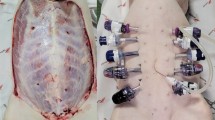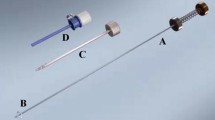Abstract
Background
This study aimed to investigate wound geometry and tissue damage caused by several different trocar types using a quantitative functional luminal imaging probe (FLIP) geometric profile and histomorphologic analysis.
Methods
Four pigs were used in this study. After general anesthesia, six different trocars were randomly inserted at preselected locations in the porcine abdominal wall. The hydration status of the animals was monitored and maintained. A bag mounted on a FLIP was used to profile the geometry of the trocar holes during distension. After the FLIP study, the abdominal wall surrounding the trocar holes was harvested. The tissue was fixed in neutral 10% buffered formalin solution for more than 24 h. The samples contained control tissue (undamaged) and test tissue (damaged) through the entire rectangular tissue block. Approximately four to seven slides were cut parallel to the surface from each sample. Each slide was photographed, and the morphometry of the hole and damaged areas were measured and displayed three-dimensionally. The histologic sections were analyzed with regard to acute damage, bleeding, and acute inflammation of the skin, muscle, and fascia.
Results
The FLIP study demonstrated differences between the six trocars. These were mainly due to differences between the Versaport Plus V2 bladed trocar with the smooth cannula, the Applied Medical Separator nonbladed access system with threaded cannula, and the VersaStep Plus trocar. The morphometry data showed the smallest hole and damage areas for the Versaport Plus V2 bladed trocar with the smooth cannula. The damaged area divided by the trocar hole area was smallest for the VersaStep plus trocar and the Ethicon Endopath bladed trocar with a stability cannula (p < 0.05). The histologic analysis showed that the VersaStep Plus trocar and the Ethicon Endopath bladed trocar with a stability cannula gave the least bleeding and inflammation (p < 0.05).
Conclusion
An agreement was found between the geometric data obtained by FLIP, the morphometric analysis, and the histology.










Similar content being viewed by others
References
Vilos GA, Ternamian A, Dempster J, Laberge PY, The Society of Obstetricians, Gynaecologists of Canada (2007) Laparoscopic entry: a review of techniques, technologies, and complications. J Obstet Gynaecol Can 29:433–465
Bhoyrul S, Vierra MA, Nezhat CR, Krummel TM, Way LW (2001) Trocar injuries in laparoscopic surgery. J Am Coll Surg 192:677–683
Tarnay CM, Glass KB, Munro MG (1999) Incision characteristics associated with six laparoscopic trocar–cannula systems: a randomized, observer-blinded comparison. Obstet Gynecol 94:89–93
Munro MG, Tarnay CM (2004) The impact of trocar–cannula design and simulated operative manipulation on incisional characteristics: a randomized trial. Obstet Gynecol 103:681–685
Shafer DM, Khajanchee Y, Wong J, Swanstrom LL (2006) Comparison of five different abdominal access trocar systems: analysis of insertion force, removal force, and defect size. Surg Innov 13:183–189
(2001) Access-related complications: an analysis of 6023 consecutive laparoscopic hernia repairs. Minim Invasive Ther Allied Technol 10:23–29
Tonouchi H, Ohmori Y, Kobayashi M, Kusunoki M (2004) Trocar-site hernia. Arch Surg 139:1248–1256
Bohm B, Knigge M, Kraft M, Grundel K, Boenick U (1998) Influence of different trocar tips on abdominal wall penetration during laparoscopy. Surg Endosc 12:1434–1438
Glass KB, Tarnay CM, Munro MG (2002) Intraabdominal pressure and incision parameters associated with a pyramidal laparoscopic trocar–cannula system and the EndoTIP cannula. J Am Assoc Gynecol Laparosc 9:508–513
Glass KB, Tarnay CM, Munro MG (2003) Randomized comparison of the effect of manipulation on incisional parameters associated with a pyramidal laparoscopic trocar–cannula system and the EndoTIP cannula. J Am Assoc Gynecol Laparosc 10:412–414
McMahon BP, Drewes AM, Gregersen H (2006) Functional oesophagogastric junction imaging. World J Gastroenterol 12:2818–2824
McMahon BP, Frokjaer JB, Kunwald P, Liao D, Funch-Jensen P, Drewes AM, Gregersen H (2007) The functional lumen imaging probe (FLIP) for evaluation of the esophagogastric junction. Am J Physiol Gastrointest Liver Physiol 292:G377–G384
McMahon BP, Frøkjær JB, Liao D, Kunwald P, Drewes AM, Gregersen H (2005) A new technique for evaluating sphincter function in visceral organs: application of the functional lumen imaging probe (FLIP) for the evaluation of the oesophagogastric junction. Physiol Meas 26:823–836
Tarnay CM, Glass KB, Munro MG (1999) Entry force and intraabdominal pressure associated with six laparoscopic trocar–cannula systems: a randomized comparison. Obstet Gynecol 94:83–88
Kolata RJ, Ransick M, Briggs L, Baum D (1999) Comparison of wounds created by nonbladed trocars and pyramidal tip trocars in the pig. J Laparoendosc Adv Surg Tech A 9:455–461
Geraci G, Sciume C, Pisello F, Li VF, Facella T, Modica G (2006) Trocar-related abdominal wall bleeding in 200 patients after laparoscopic cholecistectomy: personal experience. World J Gastroenterol 12:7165–7167
Opitz I, Gantert W, Giger U, Kocher T, Krahenbuhl L (2005) Bleeding remains a major complication during laparoscopic surgery: analysis of the SALTS database. Langenbecks Arch Surg 390:128–133
Hurd WW, Wang L, Schemmel MT (1995) A comparison of the relative risk of vessel injury with conical versus pyramidal laparoscopic trocars in a rabbit model. Am J Obstet Gynecol 173:1731–1733
Author information
Authors and Affiliations
Corresponding author
Rights and permissions
About this article
Cite this article
Zhao, J., Liao, D., McMahon, B.P. et al. Functional luminal imaging probe geometric and histomorphologic analysis of abdominal wall wound induced by different trocars in pigs. Surg Endosc 23, 1004–1012 (2009). https://doi.org/10.1007/s00464-008-0105-8
Received:
Revised:
Accepted:
Published:
Issue Date:
DOI: https://doi.org/10.1007/s00464-008-0105-8




